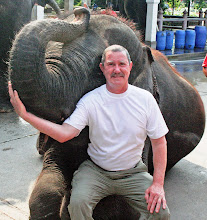Each year Anne, and her tennis partner, Judy, play in the Huntsman Senior Games held in the first couple of weeks of October in St. George, Utah. They have done well and enjoy the varied competition.
My very good friend, and flying mentor, Cliff Chaney, and his wife Phyllis live in St. George, so I like to go with Anne to the games, too. I have served as their cheering squad and booster. I also look forward each year to visiting with the Chaneys.
One year I took the time to watch some of the other sports competitions. Track and field was particularily inspiring. Each sport is divided into age brackets, e.g., 55-60, 60-65, etc. The brackets go as high as the need. At the track events there were men in their early 90's running the 50 and 100m dashes. I used to run the 50yd dash and I continued to jog many years after college. Believe me, I couldn't have kept up with those men in that dash.It was amazing!
I also had a gander at the Archery competition. They have events for longbows, compound bows, target versus 3D shooting. If there is a traditional competition using bow and arrow, they do it. Watching the archery events took me back to the farm where my brothers and I would shoot arrows into a target stuck onto a couple of stacked bales of hay in front of the barn. I remember doing the shooting, but I don't recall any spectacular achievements with the bow. What haunted me was the memory of the enjoyment of trying to hit the target.
I have reflected off and on for a couple of years about the Huntsman archery competition. This is something I can still physically do with no problems. Participating in the archery competition while Anne and Judy are whomping teams in tennis seemed like it could be a lot of fun. I had a hurdle, however, I didn't own a bow.
Somehow my thoughts were read. This last season Father Christmas presented me with a compound bow. The bow is a Mission Rally, made by Mathews Bow. It is fairly long, by compound bow standards, measuring 37". Longer bows natively shoot more acurately and are more forgiving of small archer technique flaws. This is the right bow to be using for target competitions; although it could still be used for deer hunting, if the urge ever tugged at me.
Our front parking pad measures 35yards from the garage to the driveway curbing. I set up a couple of bales of tightly tied straw in front of the garage and then measured out 10, 20, and 30 yard stands for practicing. I have gotten to the point where I can fairly consistantly group an end of arrows at the 30 yard range.
The targets used at the Hundsman Games are 48"x48" with a bullseye having a diameter of ~10". Now, that seems like a pretty large spot to be aiming at. It is large at 30 yards. However, I won't be shooting 30 yards in St. George. I will be shooting at 60, and then 50 and finally, at 40 yards. One needs to shoot 30 arrows, in 5 ends of 6 each, at each distance beginning at 60 yards.
Why can't we shoot at 40 and work our way out to 60? Well, the reason is historical. Archers of yore came upon an advancing enemy first at some distance too far away to offend. However, as they came closer, they became targetable prey. So, you shoot first at 60 yards, and then as the enemy falls to your shafts, you advance closer to clean up the mess.
It turns out, while mowing the 3/4 acre of undeveloped field at the old office lot, that it dawned on me there was a lot of distance traveled in each of those mower laps. I paced from the southern fence over 60 yards to the northern boundery bushes in front of the neighbor's 12' high cement wall. I could put a target butt in the bushes and use the field for practicing my longer ranges. I marked off 10 through 60 yards and began my shooting.
I have not been content with just shooting the compound bow. My brother, Bill, had loaned me his recurve bow and I got hooked again on traditional shooting. I have made 4 stick bows so far. One I sent to my nephew, Liam, whom I enjoyed shooting with when I traveled with his family in New Mexico. Liam reports having good success instinct shooting with his new bow.
Two of the bows I have made have broken; both after serving some long practice shooting. As I read Bowyer's books I learn that breakage is part of the acquisition of developing bow making skill. Sometimes, the bow's limb will break just because there was a hidden flaw in the grain. So, you go back to the shop and build another one.
I have just finished crafting my next bow. This one I made out of Hickory, all of the prior bows have been made out of Red Oak. Hickory, however, is a stronger wood than oak, and it should serve better. After you decide what the design of your new bow is going to be, then the wood needs to be cut and trimed and thined until it is ready to be tillered.
Tillering is a process whereby you put a loose string on the bow and gently start to add more and more stretch to work the limbs. During the tillering you can observe whether each limb is bending like the other and make adjustments, if needed. Eventually you add weight to the string and see if, for a given target weight, of say 40#, the limbs will arch to a comfortable draw length, typically 28". If after scraping a little wood off here and there you are successful, then you can put a proper bow string on your new work and have a go with a few shots.
This photo shows the bow having been tillered and strung with a proper string. I have attached 40# of weights to the string and verify that the bow will pull that weight to 28".
I have added a deer skin grip and a metal arrow rest slid under the padding.

I used strips of burlap from some old bags I had saved and stretched them onto the back of the the bow for additional tension reinforcement. The burlap was first glued and then two coats of epoxy resin was applied. Hickory is a difficult wood to break, but I was looking for some added assurance.
The bow casts the arrows true. Now, I just have to get refocused on using the compound bow and trying to nail those 6" paper plates at the 60 yard range. (My thinking is that if I can consistantly hit on or near the 6" plate at 60 yards, then my chances of doing well in St. George this October will be better.)

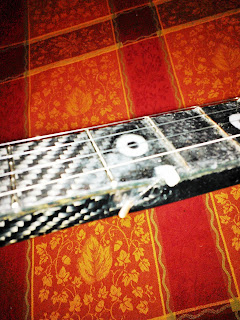
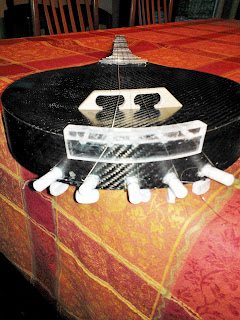
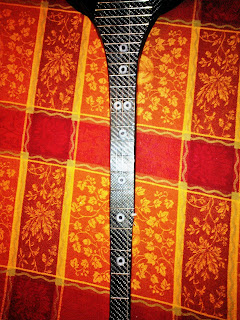

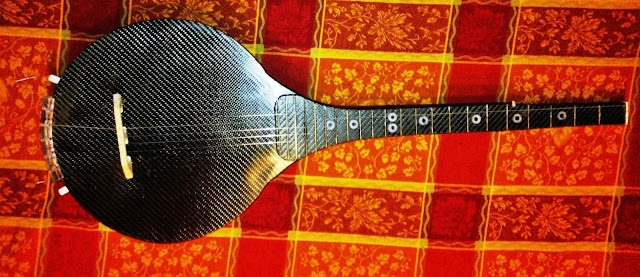



.jpg)
.jpg)
.jpg)
.jpg)






